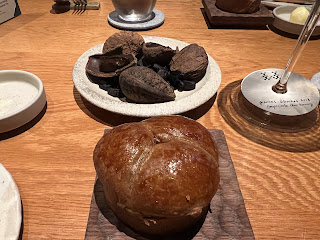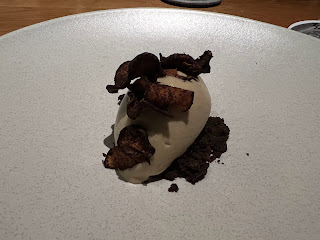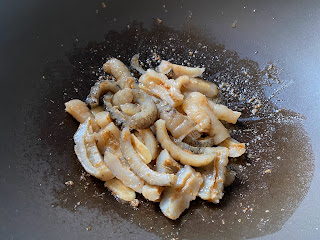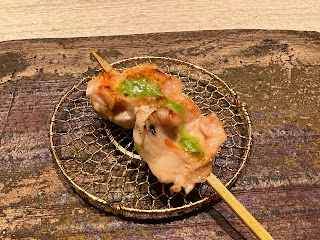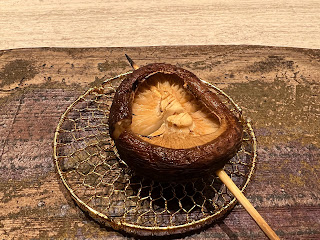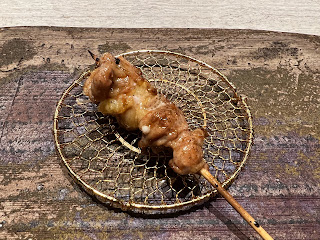Since the social unrest and the subsequent pandemic, the local dining industry has seen waves after waves of challenges, and sadly many good restaurants had to close as a result. One of those I missed was Beet. Fortunately, their Singaporean chef Barry Quek had not quit HK, and had re-opened Whey in The Wellington at Central.
Awarded Michelin 1-star shortly after opening, the restaurant had a nice, modern design using a lot of natural colours, with beautiful, curved panels on the ceiling, wooden and rattan furniture as well as Singapore cultural elements like wooden shutters on the windows, offering a comfortable, cozy and relaxing ambience.
The tasting menu ($1,390) featured a series of interesting dishes, and I also opted for wine pairing ($888). Starting with the amuse bouche, the three small bites were all innovative and delicious. The first was ‘Kueh Loyang’, a Singapore local snack. The honeycombed cookie was crunchy, with the chef added a bit of lime gel for its acidity to increase the appetize. The dill emulsion helped to give extra fragrance while the salted egg yolk provided delicate savoury note to supplement, at the same time bringing forth the Singapore root of the chef.
The second piece was Cincalok Tartlet. The pastry base had been made together with Cincalok, the fermented shrimp condiment from Malaysia to give a rich umami taste. On the tartlet, the spring onion provided nice fragrance with a bit of crunchiness, complementing with the soft, finely diced spring trout, with the caviar giving a touch of savoury.
The third piece was Chicken. The chef deep fried the thin chicken skin to crispness, then put on top some chicken liver pate, made in the form of a smooth and rich emulsion, adding some pomegranate gel to give a bit of sweetness and acidity to balance the more intense flavours of the liver pate. All three amuse bouche were fantastic on both appearance and taste.
The theme on the wine pairing was France, with the first wine paired being Charles Heidsieck Rose Reserve from Champagne. The sommelier had used a decanter to remove the bubbles, allowing the fruity and acidity to be highlighted better for pair with the beetroot.
The Beetroot had been ribbon cut and rolled like a rose, presented on a flavoured cream which got slight tartness to enhance the appetite. Underneath was turmeric curd and whey, with some dill oil to complement. The flavours were highly complex, with each spoon a beautiful combination of enjoyment.
Next was Onion Porridge. Not the normal congee of plain taste, the chef had blended caramelized onion in the porridge to give a nice sweetness, clearly noticeable from the aromas. As condiments there was lightly poached quail egg, bak kwa (the Singapore famous pork jerky), fermented mustard leaves, deep-fried rice and chives, all finely chopped. After mixing, it elevated this comfort food to another level, with the different texture and flavours of the condiments integrated seamlessly with the velvety porridge.
The signature Whey’s Brioche then followed. A mini version so that each person would have their own, the brioche was soft and fluffy, with buttery note. It was so good I finished the whole bread in no time. The chef also provided a unique buah keluak emulsion as spread, with its flavour reminiscent of cacao, plus a bit of black olive and mushroom.
The second wine paired was Domaine des Marnes Blanches Empreinte Chardonnay from Cotes du Jura. Lots of mineral, with a salty note reminding me a lot of Chinese yellow wine and sherry. A good match for the flavours of the beer used in the next course.
Chef Barry then came to greet us and introduce the Ash Baked Potato. The charcoal ash salt baked fingerling potato had great texture, with mushroom and fresh steamed razor clams served together, plus an amazing sauce that was prepared with 24-month Parmesan cheese and beer. He then shaved some Burgundy summer truffles on top, which had a milder note thus not masking the other flavours. A tiny pint of Tiger Beer was provided on the side too as a tribute to the national beer of his home country.
The third wine pairing was in fact a double glass, with Chateau Lagrezette from Cohors, and a cognac by Pierre Ferrand. The Malbec had nice fruity, leathery and smoky note to pair well with the lamb. The Cognac had been diluted with some water, nice match with the coffee flavours in the sauce.
For the main course I had chosen Coastal Lamb Saddle ($288 supplement), featuring four cuts. The charcoal grilled lamb saddle was juicy and tender, paired with a sumptuous sauce made from roasted lamb bones, local peas and a bit of coffee. The meat from the beautifully braised ribs was deep-fried with some bread crust, completely transforming its shape. The small piece of tenderloin was very soft, while the sweetbread had a fantastic texture.
My wife had chosen Lemak Three Yellow Chicken, and she had all praise for the dish as well, from the interesting texture of the crispy rice, to the rich coconut flavours infused to the chicken. I wish I could also have this in my serving. Next time perhaps I should ask if that is possible as an additional course?
The fourth wine paired was Domaine Lorenzon Cuvee 37 from Mercurey. The Pinot Noir was vinified using old barrels to impart less oaky characters to the wine, with refreshing and youthful red fruit notes supplemented with some earthy aromas.
The Curry Laksa Konjac Rice was another creative wonder. The konjac rice had a bouncy texture and the chef had cooked with curry laksa sauce, providing a bit of spicy kick but not excessive, with memorable fragrance and complex flavours. There were some firefly sotong (or squid) on top, which had been cooked with Shaoxing wine, rich in umami. On the side was some sambal sauce to add chili flavours if one prefers a more spicy taste.
The first dessert was Strawberry Sorbet. Refreshing in taste, the sorbet was made with strawberry and ginger-flower, adding small dices of strawberry on the bottom to increase the texture, along with wafer biscuit made from coconut water and kaffir lime. Pleasant and palate cleansing.
The last wine paired was Domaine Danjou-Banessy Rancio VDN from Languedoc-Roussillon. The fortified wine was of the appropriate sweetness to match with the ice-cream, and at the same time having rancio, caramel and a bit of mushroom development, pairing well with my choice of dessert.
The last course was a selection of two ice-cream, and I had picked Porcini Mushroom Ice Cream. Amazing in the flavours, the creamy ice-cream had the intense mushroom flavours, surprisingly harmonized with the sweetness. The brownie underneath was made from dark chocolate, with some Jerusalem artichoke chips on top to give extra crunchy bite.
My wife had opted for Maoshan Wang Durian Ice Cream ($138 supplement). It was not very strong in the smell, with cristal caviar on top, and some milk crispy on the bottom.
The Petits Fours highlighted the chef’s choice of ingredients celebrating his roots, included a beautiful, pearl-liked piece with a crunchy crust enclosing some soursop liquid, with the sour citrusy taste appealing.
The Bubble-Tea Puff was moist and tasty, filled with sour cream with milk-tea cream on top. The Candlenut Sweet reminded me a lot of Macadamia nut and equally wonderful.
The bill was $4,587 and in my opinion was worth every penny. Service was very good, with the staff very friendly and eager to share with us the details of each dish, apparently also had tried the food beforehand, an important factor enabling the staff to have in-depth conversation with guests. The sommelier also did a good job, choosing well the wines to pair with the food, with solid knowledge of the wines and their origin. Chef Barry also came to introduce the dishes to us several times, and personally see us off at the end. He was humble and courteous in all the interactions. A very pleasant experience that would prompt us to visit again soon.








